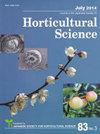Leaf Removal Accelerated Accumulation of Delphinidin-based Anthocyanins in ‘Muscat Bailey A’ [Vitis × labruscana (Bailey) and Vitis vinifera (Muscat Hamburg)] Grape Skin
Journal of The Japanese Society for Horticultural Science
Pub Date : 2014-01-01
DOI:10.2503/JJSHS1.CH-062
引用次数: 23
Abstract
Removing leaves around the grape cluster of Muscat Bailey A [Vitis × labruscana (Bailey) and Vitis vinifera (Muscat Hamburg)] cultivated in pergola style at the start of veraison increased the photosynthetically active radiation value by more than approximately 60and 30-fold compared with those of the control and grape cluster from vines grown on ground covered with reflective film (reflective-film-treated grape cluster), respectively. The improved light exposure caused by leaf removal increased total anthocyanin concentration and changed the ratios of anthocyanin derivatives in the grape skins. Total anthocyanin concentration in the leaf-removal-treated grape skins 10 weeks after veraison increased by approximately 6.5-fold compared with that of the control. In addition, delphinidin-based anthocyanin concentrations in the leaf-removal-treated grape skins increased by approximately 7-fold compared with those of the control. Leaf removal up-regulated anthocyanin-synthesis-related genes in grape skins, such as CHS, F3′H, F3′,5′H, and UFGT. In particular, the overexpression of F3′,5′H in the leaf-removal-treated grape skins suggested that leaf removal contributed to the accumulation of delphinidin-based anthocyanins in grape skin. These findings are expected to improve viticultural practices with the aim of producing dark-colored red wine made from cultivars grown in pergola style.去叶加速'麝香葡萄贝利A '[葡萄x labruscana(贝利)和Vitis vinifera(汉堡)]葡萄皮中飞虱苷类花青素的积累
在变季开始时,与地面覆盖反光膜(反光膜处理葡萄簇)的对照和葡萄簇相比,在藤架式栽培的麝香葡萄贝利A (Vitis × labruscana (Bailey)和葡萄簇(Vitis vinifera (Muscat Hamburg))去除葡萄簇周围的叶子,其光合有效辐射值分别增加了约60倍和30倍以上。去叶后的光暴露增加了葡萄果皮中总花青素的浓度,并改变了花青素衍生物的比例。换代10周后,去叶处理的葡萄果皮中总花青素浓度比对照提高了约6.5倍。此外,与对照相比,去叶葡萄皮中以飞燕草苷为基础的花青素浓度增加了约7倍。去叶可上调葡萄果皮中CHS、F3’h、F3’、5’h和UFGT等花青素合成相关基因的表达。特别是,在去叶处理的葡萄皮中,F3 ', 5'H的过表达表明,去叶促进了葡萄皮中以飞鸽苷为基础的花青素的积累。这些发现有望改善葡萄栽培实践,以生产出由藤架风格种植的品种酿造的深色红葡萄酒。
本文章由计算机程序翻译,如有差异,请以英文原文为准。
求助全文
约1分钟内获得全文
求助全文
来源期刊
自引率
0.00%
发文量
0
审稿时长
>36 weeks

 求助内容:
求助内容: 应助结果提醒方式:
应助结果提醒方式:


